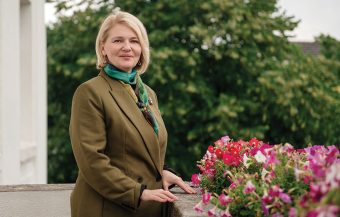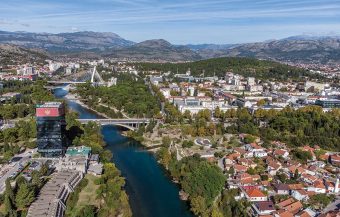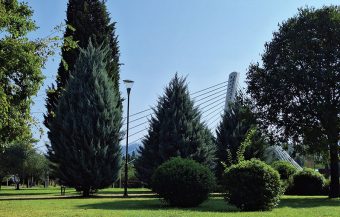
Cities, as major centers of population growth and dynamic urban development, often stand out as particularly vulnerable areas to the impacts of climate change. In this regard, Podgorica, the capital where nearly a third of Montenegro’s population resides and which, during the workweek, is visited by tens of thousands of people due to daily migrations, is no exception. Climate parameter analyses conducted so far indicate that the shift towards a warmer climate began in 1990, with each subsequent decade warmer than the previous one.
“Recorded weather and climate extremes include, among other things, more frequent and longer heat waves from May to September, a longer vegetation period, more frequent droughts accompanied by high temperatures and forest fires, and an increased number of days with very heavy rainfall. As for projected climate changes, further increases in the overall length and number of tropical waves, a rise in the number of consecutive days without precipitation, and a slight decrease in the average annual maximum wind speeds are expected. An adequate response to the impacts of climate change, or the preservation of the environment as a whole, can only be ensured through a multidisciplinary approach and collaboration at all levels, from local to international. Considering the most prominent challenges faced by Podgorica as a rapidly developing city, it is imperative to preserve space while ensuring the infrastructure necessary for a quality life,” says Professor Olivera Injac, PhD, the Mayor of Podgorica.
According to her, the priorities of the city administration include improving public transportation, preserving public green spaces through continuous maintenance of existing ones and the creation of new ones, establishing protected natural areas, continuously improving waste management systems, constructing a new wastewater treatment plant, and expanding and improving the water supply system. All city services and enterprises actively address these priorities through continuous cooperation, with a high degree of transparency, by encouraging citizen participation and engagement with the non-governmental sector to define the highest quality decisions that are important for society as a whole.
IN FOCUS:
- Challenges of Competitive Energy Production in the Global Market
- INECP – Serbia on the Path to Sustainability
- We Are Actively Reducing CO2 Emissions in Our Operations
Q: What measures are you taking to reduce air pollution?

A: The results of air quality monitoring conducted in Podgorica at both the state and local levels indicate that the air in our city is still relatively well-preserved, with the average annual concentration of PM10 and PM2.5 particles below the threshold limit, which further obligates us to maintain and improve the quality of this segment. According to data obtained through monitoring, all exceedances of these parameters, except in emergencies predominantly caused by fires during the summer period, occur during the heating season, which presents a particular challenge for local governments. The main recommendations for improving air quality in monitoring reports relate to improving public transportation, promoting and encouraging alternative modes of transport, expanding urban green areas, and enhancing energy efficiency. The city has a significant number of roundabouts, which reduces traffic congestion and thus decreases pressure on air quality.
We are also working on establishing cycling infrastructure. In this context, a significant project is “Podgorica on Two Wheels,” which subsidizes the purchase of bicycles and electric scooters, a project that has garnered considerable interest. Podgorica is characterized by the expansion of urban green areas, with over 300,000 m² of new and revitalized spaces in the past few years. For more efficient planning and management, the Green Space Cadastre of Podgorica was completed at the end of 2022, spanning about 1,200 hectares of public green spaces. The cadastre was developed as an intuitive, user-friendly application containing data on trees, shrubs, recreational areas, and urban furniture, searchable by various criteria. Recently, we have also begun developing the concept of green roofs, which is a particularly significant mechanism in this context in urban areas, and we are conducting activities to reforest the hills surrounding Podgorica.
Q: How much are you investing in the development of city parks and botanical gardens, and what are the plans for implementing the so-called green belt around the city?
A: “Green Podgorica” is a vision to which we are fully committed, and the efforts we put into this area have already yielded visible results. As a city that ranks as the fifth greenest city in Europe in the urban green infrastructure category, we are continuously working to make the city greener. In the past year, Podgorica has gained more than 35,000 m² of new parks, over 30,000 m² of landscaped areas, nearly 20,000 m² of developed urban pockets, and almost 100,000 m² of new green spaces, which makes us very proud. In addition, the Micro 020 project, implemented by the Office of the Chief City Architect, focuses on revitalizing neglected and forgotten urban pockets, that is, smaller areas in the city that are in poor condition. Within this project, we will soon have about ten ready project solutions based on which we will develop an equal number of public spaces throughout the city.
Since the beginning of the year, we have arranged numerous park areas in several neighborhoods in Podgorica.
Additionally, several smaller green spaces have been constructed and reconstructed, and tree rows have been planted where technically feasible. The reconstruction of Karađorđev Park in the city center and the construction of a large park in the Zabjelo neighborhood will soon begin. The creation of the so-called green belt around Podgorica, with the planting of tens of thousands of new seedlings, further strengthens efforts to create a sustainable urban environment. This project will continue into the fall, with another planting season set to begin. Along with the formation of linear greenery and the development of smaller green areas, the goal is to connect suburban and urban areas into a unified system of city greenery. There are also plans to develop Lješkopoljska Gorica Hill, which will be an essential part of the city’s green infrastructure. It will serve as another foundation for adapting to climate change by establishing ecological stability and improving residents’ quality of life.
Q: How have you regulated proper waste disposal, and how have you improved waste management?

A: At the end of 2006, following the decision of the City Assembly, the Podgorica government formed the Deponija Company, which began operations in 2007. Its primary role was the disposal of municipal waste from the territory of Podgorica, Cetinje, and Danilovgrad municipalities, as well as the urban municipalities of Tuzi and Zeta, now independent municipalities. The urban planning envisaged six sanitary landfills. All were constructed following Directive 1999/31/EC on the landfill of waste (later amended by Directive (EU) 2018/850). Subsequently, operations were defined by the Law on Waste Management and the Regulation on the Specific Characteristics of Locations, Construction Conditions, Sanitary-Technical Conditions, Operation, and Closure of Landfills. In mid-2010, the Regional Recycling Center for Municipal Waste and the Recycling Center for Waste Vehicles were put into operation.
Regarding the increase in the share of renewable energy sources, Deponija’s role is reflected in initiating a cogeneration project, i.e., generating electricity and heat from the combustion of landfill gas. A public call is currently open for the development of a feasibility study that will provide answers on the profitability of this project. Given that three sanitary landfills have been filled and closed, and the fourth one is active with space remaining for landfills 5 and 6, there is optimism that this study may yield very encouraging results, allowing the construction of the cogeneration plant to begin next year.
Interview by Mirjana Vujadinović Tomevski
Read the whole interview in the new issue of the Energy portal Magazine ENERGY TRANSITION

